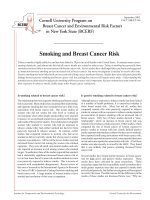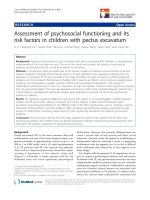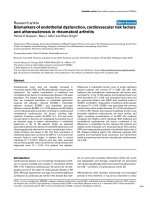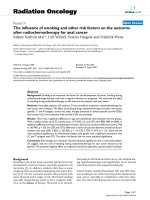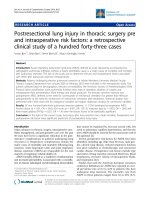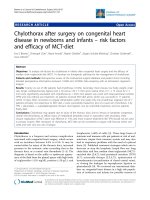Prevalence of obesity and associated risk factors in chinese pre school children aged 6 to 72 months old in singapore 4
Bạn đang xem bản rút gọn của tài liệu. Xem và tải ngay bản đầy đủ của tài liệu tại đây (532.85 KB, 59 trang )
CHAPTER 4
4. DISCUSSION
4.1
Summary of the study
Our study, part of a large population-based study titled “Strabismus,
Amblyopia and Refractive Error in Singapore Chinese Preschoolers (STARS),”
highlights the prevalence of overweight and obesity and its associated risk factors
in Chinese preschool children aged 6 to 72 months in Singapore.
The prevalence of overweight was 8.1% (“CDC BMI for age” reference),
7.6% (“IOTF BMI for age” reference) and 7.0% (“Singapore BMI for age”
reference). The prevalence of obesity was 7.1% (“CDC BMI for age” reference),
3.9% (“IOTF BMI for age” reference) and 5.3% (“Singapore BMI for age”
reference). Based on the “CDC BMI for age” reference, the prevalence of obesity
in Chinese preschool children in the STARS was comparatively lower than that of
children from the United States,57 Chile,,61,62 and Italy63.
Our results showed that the prevalence, using the “IOTF BMI for age”
reference, probably underestimated the overweight and obesity problem in our
local paediatric population compared to the “CDC BMI for age” reference.
However, the estimated prevalence of overweight and obesity based on the “CDC
BMI for age” and “Singapore BMI for age” references were comparable, even
though the cutoffs used to define overweight and obesity by the “Singapore BMI
118
for age” reference (the 90th and 97th percentiles for overweight and obese
respectively) are slightly higher than for the “CDC BMI for age” reference (the
85th and 95th percentiles).
Based on the “CDC BMI for age” reference, higher birth weight
(p=<0.001), longer duration of preschool hours per day (p=0.01) and longer total
time spent on sedentary activities per day (p=0.02) were found to be significantly
associated with overweight/obesity status after adjusting for other variables (age,
gender and father’s education level). Furthermore, linear regression analysis
demonstrated that higher birth weight (p=<0.001) and longer time spent on
watching television hours per day (p=0.02) were significantly associated with
BMI after controlling for age, gender and father’s education level.
4.2
Prevalence of obesity
Although the prevalence of obesity and its associated factors in preschool-
aged children (<6 years old) has been reported by other countries for their
populations, the present study is one of few in Singapore to estimate the
prevalence of overweight and obesity and evaluate the associated risk factors in
young Chinese preschool children, specifically, those aged 6–72 months.
It is important to compare the prevalence of obesity with the similar aged
group from different countries (the United States, Germany, Chile, Italy, Canada
and Jordan) with Singapore Chinese because it may highlight the status of
119
prevalence of obesity in Singapore among different countries and provide basis
information for planning and implementation to control the prevalence.
Countries with lower prevalence compared to Singapore
China
A study in China showed a lower prevalence of overweight/obesity
compared
to
our
study.54
The
Chinese
study
reported
an
overall
overweight/obesity prevalence of 7.4% (95% CI: 7.3%,7.5%) which was lower
than that of our present study (11.5%, 95%CI: 10.2%,12.8%) based on the same
“IOTF BMI for age” reference. The Chinese study evaluated children aged 3.5–
6.4 years (n=262,738), born between 1993 and 1996 to a mother residing in one
of the defined study areas (northern rural, southern rural and urban area of China)
for at least one year. However, the Chinese study did not specify the response
rate.
In contrast, the sampling method used in the Chinese study,54 including all
children who were born between 1993 and 1996 to mothers residing in one of the
defined study areas for at least one year, was more complete compared to our
study. However, although height and weight measurements were done by locally
trained health workers using standardized measuring procedures, the Chinese
study did not indicate the number of health workers who participated in each of
the three study areas. Therefore, the inter-observer variability in the Chinese study
cannot be assessed. Although the instruments used in the study were all
calibrated, it did not specify whether the instruments used in different study sites
120
were calibrated against each other, using the same weights, to ensure there were
no discrepancies in measurements. Both the Chinese study and our study used
standardized measuring procedures at all study sites which were administered by
trained health workers.
Although both the Chinese study and our study conducted in Chinese
preschool aged children, we cannot expect to have the similar prevalence between
China and Singapore because there might be differences in the environmental
factors and life styles between two countries.
Germany
A German study performed by Kalies et al. (2002)60 found 2.8% of the
prevalence of obesity, using the “IOTF BMI for age” reference. The Germany
study was conducted in 126,083 children aged 5–6 years who participated in the
school health examination and had a response rate of 97.1%. Comparing similar
age groups (60.0–72.0 months), the prevalence of obesity (boys=7.2% and
girls=4.9%) in our study was higher than that in Germany (2.8% for both boys
and girls). Therefore, the prevalence of obesity was higher in our study than that
in the Germany study, and this was more pronounced when we compared the
same age groups. The differences in the study design, i.e. ours being populationbased while theirs is a school-based study design may be one of the reasons
involved in the lower prevalence of obesity in Germany.
121
Countries with higher prevalence compared to Singapore
Based on the “CDC BMI for age” reference, the prevalence of obesity in
our study was lower than that in the United States,57 Chile,61 Italy63. Furthermore,
based on the “IOTF BMI for age” reference, the prevalence was also higher in
Jordan,56 Canada,59 Chile62 and Italy63, compared to our study.
Although the studies from Chile,61,62 Italy,63 Jordan,56 Canada59 had fairly
large sample sizes, they were not population-based studies. These studies were
conducted in children who underwent obligatory health examinations when
entering kindergarten or first grade. Therefore, the children who attend preschool
were more likely to be from the middle or high income families and that factor
could contribute to the higher prevalence compared with our population-based
study.
The United States
The population based study conducted in the United States57 described a
prevalence of obesity as 10.4% (using the CDC reference) for children aged 2 to 5
years (n=3,281) who were included in NHANES (2007-2008), a continuous
programme which assess a variety of health and nutrition measurements of
children and adults in the United States. . The prevalence of obesity from this
study was higher than that of our study (10.4% vs. 7.1%). The higher prevalence
of obesity in the United States was expected because it is a more urbanized
country and it adopts more sedentary life styles for many years, compared to
Singapore.
122
Chile
Stanojevic et al. (2008)61 conducted a study in children (n=25,013) aged
2–5 years from the Junta Nacional de Jardines Infantiles programme (one of the
national food supplementation programme) and found the prevalence of obesity
was 16.35% using the CDC reference. Although the age range used in the Chilean
study was similar to our study of 6–72 months old children, participating children
in the study were from low and middle income families who registered with the
programme and the Chilean study did not specify the study’s response rate. Thus,
they might not be representative of all the preschool-aged children in Chile. Using
the CDC reference, the prevalence of obesity was about two times higher in the
Chilean study than our study of Chinese preschool children (16.35% vs. 7.1%).
Another school-based study in Chile62 included a large sample of 6–year–
old first grade children (n=199,444) and evaluated the prevalence of obesity using
three criteria (CDC and IOTF references and weight–for–height z-scores.). Based
on the CDC reference, the prevalence of obesity in the Chilean study was 14.7%
and 15.8% for boys and girls, respectively, approximately two times higher for
boys (14.7% vs. 8.3%) and three times higher for girls (15.8% vs. 5.7%) than the
counterparts in our study. Comparing a similar age group (60.0–72.0 months) in
our study with the 6–year–olds in the Chilean study, the prevalence of obesity for
girls in our study was also approximately half that found in the Chilean study
(8.1% vs. 15.8%). However, the prevalence of obesity in boys aged 6 years was
similar (12.8% vs. 14.7%) in both studies.
123
Using the IOTF reference, the prevalence of obesity was 7.2% for boys
and 7.5% for girls in the Chilean study.62 Compared to our study, the prevalence
of obesity from the Chilean study was almost two times higher for boys (7.2% vs.
4.6%) and more than two times higher for girls (7.5% vs. 3.2%). In addition,
comparing similar age groups (60.0–72.0 months) in the present study with the 6–
year–old group in the Chilean study, the prevalence of obesity for girls in our
study was also approximately half that of the Chilean study (4.9% vs. 7.5%).
However, the same prevalence of obesity for boys aged 6 years (7.2%) was found
in both studies. Therefore, the prevalence of obesity in Singapore was lower than
that in Chile62, comparing the overall as well as the similar age groups.
Italy
Maffeis et al. (2006)63 conducted a study in Italy of 2,150 children aged 2–
6 years. The prevalence of overweight and obesity was evaluated using three
criteria (the CDC and IOTF references and Italy’s National BMI reference tables).
The study utilized the same standardized methodology which was performed by
two teams of paediatricians at two study sites (located at the northeast and south
of Italy). The study achieved a high response rate of 89.6% and children were
randomly selected from the registers of kindergartens at the two study areas.
Using the “CDC BMI for age” reference, the prevalence of obesity for children
aged 2–6 years in Italy was about two times higher than that of our study (16% vs.
7.1%). A similar result was found, using the “IOTF BMI for age” reference: the
124
prevalence of obesity (8.0%) from the Italian study was nearly two times higher
than that of our present study (3.9%).
Jordan
Among the studies using the “IOTF BMI for age” reference, the
prevalence of obesity for boys (4.6%) and girls (3.2%) in the present study were
lower than that in the Jordan study (boys= 20.8% and girls= 19.1%)56. The study
from Jordon sampled children aged 3–6 years (n=2,012) from randomly selected
paying nurseries, and 1,695 children participated. Jordan, a developing country in
the Middle East, had a higher prevalence of obesity compared to Singapore
Chinese. Jordan is one of the highest spenders among the Middle East region’s
highest spenders on education76 and has an impressive educational development
with a high literacy rate of 89%77. In Jordan, there are governmental free nurseries as
well as fee-paying nurseries; preschool children attend these two types of nurseries in a
ratio of 1:15.
56
This ratio suggests that most Jordanian children attend the paying
nurseries, and they might come from the middle and high income families. This may be
the reason why the prevalence of obesity in Jordanian study was higher than that
of our study.
Canada
Based on the “IOTF BMI for age” reference, a study conducted by
Canning et al. (2004)59 (n=4,161) from Canada showed a higher prevalence of
obesity than that in the present study. The targeted population was children (born
125
in 1997 in the province of Newfoundland and Labrador) who participated in the
Preschool Health Programme. The response rate varied by regions and ranged
from 73.0% to 84.0%. The prevalence of obesity in the Canada study was two
times higher than that of our study (boys= 7.8% vs. 4.6% and girls= 8.2% vs.
3.2%).
Summary of prevalence in comparison
Using the “IOTF BMI for age” reference, our study had a slightly higher
prevalence of overall overweight/obesity in Singapore Chinese preschool children
than that of the Chinese study54 and the Germany study60.
The slight different in the overall prevalence of overweight/obesity
between our study and the Chinese study54 may be due to the age differences
between these two studies (based on the “IOTF BMI for age” reference; 2 to ≤6
years in the present study and 3.5–6.4 years in the Chinese study). Another
possible reason is the methodological constraints in the two studies. Although
both studies used standardized measuring procedures, the instruments used may
not be the same. Our study used the Seca-220 as the instrument to measure height
and weight for children who were 2 years old and above. Unfortunately, the
Chinese study54 did not mention the name and model of instrument used to
measure height and weight in their study.
One possible explanation for the lower prevalence in Singapore Chinese
preschool children as compared to the children in Jordan,56 the United States,57
126
Canada,59 Chile,61,62 and Italy63 is the difference in lifestyles, quantity and quality
of nutrient intake between the Western people and the Chinese.
Another possible reason is that the “CDC BMI for age” reference was
based on the American population and that standard or yardstick may not
accurately reflect the prevalence of obesity among different populations form
other countries, where people have different body compositions and cultural
behaviors.
4.2.1 Age
Our study showed an increasing trend of prevalence of obesity with age
for both genders based on the “CDC BMI for age” and “IOTF BMI for age”
reference (p=<0.001 for both references). However, no specific trend was present
for prevalence of overweight with age in our study.
This increasing trend of prevalence of obesity with age was also found in
the Chile study61 (using the “CDC BMI for age” reference) although the Canadian
study59 (using the “IOTF BMI for age” reference) did not find significant
differences between different age groups in the prevalence of overweight or
obesity.
Interestingly, the Chinese study54 (based on the “IOTF BMI for age”
reference), demonstrated an inverse trend of prevalence of overweight/obesity
with age in both boys and girls. The Chinese study was a population-based study
conducted on children aged 3.5–6.4 years (n=262,738) from the northern rural,
127
southern rural and urban areas of China. In contrast, another study from China
performed by Jiang J et al. (2006)66 (n=930) showed an increasing trend of the
prevalence of obesity with age. The Chinese study66 was conducted in children
aged 2–6 years from randomly selected five large kindergartens in two urban
districts of Beijing, China (response rate=89.1%).
Insignificant difference between the age groups in the prevalence of
overweight or obesity (p≥0.05) was reported in the Canada study59 (n=4,161). The
study included children aged 3.5–5.5 years (born in 1997) from the province of
Newfoundland and Labrador who participated in the preschool health check
programme. There was no trend of increasing prevalence of overweight with age,
which was consistent with our study, whereas, for the prevalence of obesity, the
Canadian study did not have an increasing trend as age increased, as observed in
the present study.
Nevertheless, the consistent finding of increasing prevalence of obesity
with age was seen in the Chilean study61 (n=25,013). The Chilean study described
the cross-sectional obesity trends in Chilean preschool children aged 2–5 years
who participated in the Junta Nacional de Jardines Infantiles programme (one of
the national food supplementation programme) from 1996 to 2004. The results
from the Chilean study showed that the prevalence of obesity increased with age
(OR 1.04, 95% CI: 1.038,1.047), and the odds of obesity increased by
approximately 10% for each year (test for trend OR 1.08, 95% CI: 1.07,1.09,
p<0.001) increment during the 9-year study period from 1996 to 2004. Although
both the Chilean and our studies conducted prevalence surveys on large sample
128
sizes, the Chilean study was not a population-based study and its response rate
was also not mentioned. However, both studies showed a consistent increasing
trend in the prevalence of obesity with age in preschool children.
In our study, the prevalence of overweight and obesity were the highest in
the age group of 60.0–72.0 months in both genders based on the “CDC BMI for
age” and “IOTF BMI for age” references. These findings were consistent with the
adiposity rebound of approximately 6 years of age.78 In this second period of
rapid growth in body fat, both the size and number of adipocytes increase,79,80 and
it may be the reason for the highest prevalence of overweight and obesity in this
age group of 60.0–72.0 months among the 24.0–72.0 months in our study.
Using the “Singapore BMI for age” reference, the prevalence of obesity
was highest in the youngest age group (6.0–11.9 months) among the 6.0–72.0
months for both genders. This result is consistent with the first period of rapid
growth in the size of the adipocytes during the first year of life.79,80 This finding
cannot be seen for the “CDC BMI for age” and “IOTF BMI for age” references
because both references cannot be applied in children less than 2 years old.
However, using the “Singapore BMI for age” reference, the second period of
increased adiposity was still not present in the oldest age group (60.0–72.0
months).
129
4.2.2 Gender
Our study showed that boys were more likely to be obese than girls
(p=0.03), using the “CDC BMI for age” reference. However, the prevalence of
obesity, based on the “IOTF BMI for age” and the “Singapore BMI for age”
references, did not show gender differences (p=0.13 and 0.94, respectively).
As for the prevalence of overweight, there were no statistically significant
differences between genders using all three references in our study (p=0.10 for the
“CDC and IOTF BMI for age” references and p=0.39 for the “Singapore BMI for
age” reference). Our results were consistent with that of the studies from the
United States57 and Canada59. Nevertheless, using the “IOTF BMI for age”
reference, our study had inconsistent results compared to other studies from
Italy63 and China54. Similarly, there was an inconsistent result compared to the
Chilean study, using the “CDC BMI for age” reference. 61
In the United States, a study conducted by Ogden et al.57 in children aged
2 to 5 years (n=3,281), using the “CDC BMI for age” reference, showed no
gender differences in the prevalence of overweight, and this result was consistent
with ours. The data were derived from NHANS 2007-2008.
The Canadian study59 analysed 4,161 children aged 3–5 years (born in
1997) who enrolled in the preschool health check programme in 2002. Using the
“IOTF BMI for age” reference, there were no significant differences between
genders in the prevalence of overweight or obesity (p=≥0.05).
Gender differences were shown in the study conducted by Maffeis et al.
(2006)63 in 2,150 children aged 2–6 years who were randomly selected from a
130
kindergarten registry in Italy. Using the IOTF reference, the study showed that
girls had a slightly higher prevalence of overweight than boys (p=<0.001).
Liu et al. (2007)54 studied a sample of Chinese children aged 3.5–6.4 years
(n=262,738) in the northern rural and southern rural and urban areas of China by
using the “IOTF BMI for age” reference and showed that girls were more likely to
be overweight or obese than boys (OR=1.14, 95% CI: 1.11,1.17). Using the same
reference (“IOTF BMI for age” reference), their findings were different from
ours, i.e. there were no gender differences in the prevalence of overweight or
obesity.
Using the “CDC BMI for age” reference, a study from Chile (2008)61 also
observed an inconsistent result of gender differences in the prevalence of
overweight in Chilean preschool children (n=25,013) as compared to our study.
The Chilean study included children aged 2 to 5 years participating in the Junta
Nacional de Jardines Infantiles programme (one of the national food
supplementation programme) and showed that the prevalence of overweight was
higher in girls (OR=1.26, 95% CI: 1.038,1.047) than boys.
Overweight and obesity are multi-factorial etiologic weight related
statuses. Therefore, all environmental factors and genetic factors may influence
the prevalence in genders. For example, boys are more favored than girls in
Chinese tradition, and this may also be one of the possible explanations. Other
possible reason is boys may eat more than girls or girls are pickier in eating than
boys. Moreover, different parental upbringing patterns may also affect the eating
habits of children.
131
Another possible indirect explanation is the statistically significant
(p=<0.001) greater mean birth weight of boys (3,137.8 grams) as compared to
girls (3,036.7 grams) found in our study. The consistent finding of statistically
significant gender difference in birth weight were also reported in other studies.8183
Thus, higher birth weight in boys may also explain the higher prevalence of
obesity in boys than girls in our study.
4.3
Associated factors for overweight or obesity
Obesity and its weight-related health problems are important health issues
in all countries because of its causal effect on increasing morbidity and mortality.
Therefore, evaluating the causes of obesity [i.e; energy imbalance between energy
intake (diet) and energy expenditure (physical activity)] such as insufficient
energy expenditure, excessive snacking and excessive eating of fast food diet is
the main key factor in prevention of overweight/obesity. On the other hand,
understanding the associated factors is helping to generate hypotheses for testing
causal factors. To implement effective prevention and intervention, evaluation of
either the causes or associated factors in early life play an important role. Prior
studies from other countries have investigated the very early risk factors for
overweight and obesity in preschool-aged children. Likewise, our study examined
the influences of the risk factors on the overweight/obesity in Singapore Chinese
preschool children. The possible predictors include birth weight, maternal prenatal history (maternal smoking and alcohol consumption during pregnancy),
132
breastfeeding, behavioral factors of the child (physical activities and sedentary
activities) and socioeconomic status (father’s education, mother’s education, total
combined monthly income).
4.3.1 Birth Weight
Birth weight, a possible surrogate of intrauterine environment and foetal
growth, is believed to be one of the potential risk factors for BMI and
overweight/obesity status in childhood. Therefore, many studies have evaluated
the association of birth weight and weight status in childhood. In our study, birth
weight was positively associated with overweight, obesity and overweight/obesity
(p=<0.001) in univariate analysis.
In logistic regression analysis, the association of birth weight with
overweight/obesity remained significant (p=<0.001) after adjusting for age,
gender, father’s education, number of hours per day the child spent at preschool,
and time spent in sedentary activities.
In addition, the association of birth weight and BMI was analysed using a
linear regression model. The results showed a relationship between birth weight
and BMI (p=<0.001), after adjusting for age, gender, father’s education, number
of hours per day the child spent at preschool, and time spent in sedentary
activities.
A similar result was shown by a cross-sectional study conducted on 1,412
preschool children from both public and private nursery schools in five districts of
133
Cyprus (response rate=70.6%).68 Consenting parents were asked to quote the
information of birth weight from a health booklet. The categories of birth weight
were defined differently from the present study, and the distribution of birth
weight was higher in the Cyprus study as compared to our study. The highest
birth weight group was defined as >4,000 grams in the Cyprus study, compared to
≥3,390 grams in our study. Therefore, we compared the ‘3,501–4,000 grams’
category with that of the highest quartile (≥3,390 grams) in our study. The results
from the Cyprus study showed that the odds of being obese for birth weight
between 3,501–4,000 grams (defined by the IOTF reference) in children aged
2.0–6.9 years was 4.61 times greater than that of birth weight between 2,501–
3,000 grams (p=0.003) after adjusting for age and sex. This OR (4.61) was similar
to the OR found in our study (4.19) in which the odds of obesity was compared
for birth weight ≥3390 grams versus birth weight <2,825 grams (p=< 0.001).
Another consistent result was shown in the study by Moschonis et al.
(2008)69 from Greece (n=2,374). The results showed a positive association
between birth weight and overweight (≥95th percentile) in children aged 6 and 12
months. This study derived the data from GENESIS (the Growth, Exercise and
Nutrition Epidemiological Study In pre-Schoolers): a cohort study of children
aged 1–5 years from randomly selected public and private nurseries as well as day
care centres within municipalities in five counties in Greece. Their study’s
response rate varied from 54 to 95%. The birth weight categories defined in the
Greek and present studies were different. The Greek study grouped three
categories of children into born as: small for gestational age (<10th percentile);
134
appropriate for gestational age (10th–89th percentile); and large for gestational age
(≥90th percentile). The results showed that the odds of being overweight (≥95th
percentile) at 6 and 12 months of age were 4.59 and 2.19, respectively when
children born large for gestational age were compared to those born appropriate
for gestational age. However, the positive association was not seen in the 1–to–3–
year–old– and 3–to–5–year–old–age groups in the Greek study.
There is a general understanding that a more favourable intrauterine
environment leads to higher birth weight, except for macrosomia seen in infants
of diabetic mothers. Many believe that the foetus in utero adapts himself/herself
to the conditions during gestation. Thus, many studies have focused on factors of
prenatal and perinatal period such as maternal obesity, nutrition, behavioral, and
psychological factors. Children who was exposed to famine in utero or who
experienced maternal restraint in utero were delivered with low birth weight and
among those who developed ‘catch-up’ growth in the first two years of life are
more likely to be overweight/obese at five years of age.84,85 However, most low
birth weight infants are likely to remain shorter and lighter in early childhood than
children with high birth weights despite accelerated weight gain in the first year
of life.85 On the other hand, high birth weight children remain taller and heavier
than their normal birth weight counterparts. 85
In overall, intrauterine ‘programming’
86
as well as genetic factor might
play important roles in determining the weight at birth. Nevertheless, the positive
relationship between birth weight and overweight or obesity in later life is still
puzzling. In high birth weight infants compared to normal birth weights, there
135
might be some differentiation in the hypothalamic centre which regulates food
intake or in adipocyte regulation.87 Therefore, there is still a gap and further
research is needed to reveal the fundamental background understanding of the
positive association between birth weight and overweight/obesity in childhood.
In addition, studies had suggested that the associations between birth
weight and BMI or overweight/obesity did not necessarily reflect high adiposity
in high birth weight infants.88 Many studies suggested that the positive association
between birth weight and BMI could result from increasing lean body mass rather
than adiposity.89-93 The fact was affirmed in preschool children by Hediger et al.
from the US (1998).93 The results showed that in ‘large for gestational age’
children, excess adiposity was less than excess muscularity. Therefore, further
research is needed to investigate more details of the association between birth
weight and adiposity as well as muscularity.
4.3.2 Duration of sedentary activities (Total sedentary activities,
Watching television) per day
Low energy expenditure is one of the most widely cited etiologic factors
for overweight or obesity. The results of our present study showed that sedentary
activities/watching television were positively associated with the likelihood of
overweight/obesity. This positive relationship was also seen in France,64 China,66
and Japan.72
136
Among the studies with consistent positive associations, the study
conducted by Lioret et al. (2007)64 was the first nation-wide study; it included
1,016 children aged 3 to 14 years in France. Participating children were grouped
into preschool (3–5 years old), primary (6–10 years old) and secondary (11–14
years old) school levels. This study showed that sedentary behaviour, in this case,
time spent either watching television or playing video-games in an ordinary week
was positively associated with overweight (defined by the “IOTF BMI for age”
reference) in children aged 6 to 14 years. However, this positive association was
not found in children aged 3 to 5 years. The adjusted odds of being overweight for
longer sedentary time were 2.1 (0.7–6.6) in children aged 3–5 years and 2.3 (1.1–
4.8) in children aged 6–14 years compared to their counterparts who had shorter
sedentary time.
Another study was conducted by Jiang et al. (2006),66 evaluating the risk
factors for overweight in children 2 to 6 years old (n=930) who were randomly
selected from five large kindergartens in two urban districts in Beijing, China.
The Chinese study showed a significant association between television hours and
overweight (defined by the “IOTF BMI for age” reference). In this study, children
who watched television more than 2 hours per day had 1.56 times (1.17–2.09)
greater odds for being overweight compared to those who spent less than 2 hours
watching television per day. Our present study did not observe an association
between television watching per day and overweight but found associations with
obesity and combined overweight and obesity. In the linear regression analysis of
our present study, the association of time spent watching television with BMI
137
showed that there was 0.07 kg/m2 (p=0.01) increase in BMI for every 1 hour
increase in television watching time.
One of the sub-studies from the Toyama cohort study from Japan72 also
showed a consistent result with the present study. A total of 8170 children who
were born in 1989 in Toyama Prefecture, Japan, participated in the study
(response rate=95.1%). The study showed that the time spent watching television
(≥4 hours per day) was significantly higher among overweight children (≥90th
percentile). Moreover, the results showed a dose-dependent trend between BMI
and television watching hours. Similar findings were seen in our present study
which showed that there was a relationship between time spent on television
watching and BMI (p=0.01) after adjusting for age, sex, father’s education and
birth weight.
More time spent in sedentary behaviour indirectly means less habitual
physical activity energy expenditure. Watching television is one of the most
common sedentary behaviours in children in developed countries. Furthermore,
advancing technologies has allowed for the creation of attractive programmes that
enable children to become addicted to watching television for longer times. In this
way, children spend more time watching television and increase the number of
sedentary hours per day. Moreover, some sedentary behaviours such as reading or
watching television may promote consumption of unhealthy snacks or soft drinks
which aggravates obesity even further.
138
4.3.3 Duration of preschool hours per day
Obesity as well as combined overweight and obesity were negatively
associated with the number of hours per day the child spent at school. This
association may have been first analysed in Singapore, where it showed the
protective effects of preschool on the likelihood of obesity or overweight/obesity.
In Singapore, the daily programme for preschool includes preparing
children for formal education, and developing personal and social skills by
involving them in games, music and outdoor play.94 Therefore, children who go to
preschool might be exposed to more physical activities, compared to those who
stay at home. Finn K et al. (2002) showed that child care centre was a determinant
factor in predicting physical activity in children.95 There was also an association
between the area (square footage) of childcare centre and percentage of body fat
among 12-month-old infants.96
In addition, the preschools often provide meals to children in full-day
programmes. In 2005, the Health Promotion Board (HPB) collaborated with the
Family Services Department of the Ministry of Community Development, Youth
and Sports (MCYS) to introduce the “Healthy Eating in Child Care Centres
Programme”.97 As of October 2009, 240 child care centres in Singapore (out of
777) achieved the “Healthy Eating in Child Care Centres Award.
98,99
The
programme includes assessment of key dietary needs and how nutritional
education is taught in the classroom, provides training for childcare centre
supervisors and cooks, and gives a yearly evaluation by the HPB.100 Therefore,
139
preschools are encouraged to provide healthy meals according to the children’s
nutritional needs and to shape children’s eating habits and preferences.
Overall, promoting compulsory group physical activities and having a
healthy balanced diet might have beneficial effects in the association between
number of preschool hours and the likelihood of obesity or overweight/obesity.
4.3.4 Physical activities
Among the three basic component of energy expenditure: resting energy
expenditure (REE), thermal effect of food (TEF) and voluntary physical activity,
physical activity is the most variable and modifiable component of energy
expenditure.101 REE remains relatively stable provided that an individual’s weight
and health status unchanged.101 In addition, TEF is the energy expenditure used in
the digestion of food consumed, and it is relatively small with the total daily
energy expenditure.101 Therefore, the absence of physical activities alone can
represent the absence of energy expenditure, leading to an increase in the body fat
content.
There were different results from different studies regarding the
association of physical activities and child overweight.64,66 However, in our study,
playing outdoors (p=0.25) and outdoor leisure activities (p=0.31) were not found
to be associated with overweight/obesity. The possible reasons for different
results between studies are the variations in methods which physical activity is
measured and the design of the studies.
140
4.3.5 Other factors
The present study did not find an association of overweight/obesity with
mother education, income, breastfeeding and maternal smoking or alcohol
consumption during pregnancy. However, some studies have reported an
association of the abovementioned factors with overweight or obesity 65,66,69 while
others have not.67,68 Moreover, in our study, only watching television appeared as
an associated factor with overweight/obesity while other sedentary activities
(playing computer/television/hand held video games and reading, drawing and
coloring activities) were not found to be associated with overweight/obesity.
4.4
Strengths of the study
The current study is among the few studies, evaluating the prevalence of
obesity in the very young age group (6– to 72–month–old). Our present study also
examines the associated early risk factors of obesity in preschool Chinese children
aged 6– to 72–month–old in Singapore.
This is a population-based study with a large sample size of children
(3,009) and a good response rate (72.3%) from the large study area of SouthWestern and Western parts of Singapore. This shows that selection bias is
minimized, and it can also be regarded as one of the strengths of our study.
Regarding measuring the height and weight, all staffs in the study were
trained to perform the same standardized measurement procedures and methods in
141
the two study sites. To maintain the consistency of measurements, only two
members of the research team were involved in the measurement station.
Last but not least, the present study allows an international comparison of
the prevalence of overweight and obesity in Chinese preschool children in
Singapore to plan public health programmes for prevention and intervention of
overweight and obesity.
4.5
Limitations of the study
The main limitation of the current study is the use of BMI to estimate
body fatness. Although it is a common, inexpensive and practical method of
obesity measurement, it cannot distinguish between body fatness and muscularity.
Therefore, the accuracy and preciseness in determining body fat, using BMI,
cannot be as accurate and precise as using dual energy X-ray absorptiometry
(DEXA), the bioelectrical impedance analysis, computed tomography (CT/CAT
scan), or magnetic resonance imaging (MRI/NMR).
The equipment used to measure height and weight in the two different
study sites were calibrated separately at its respective study site. Therefore, the
validity of accurate and precise measurement cannot be ignored.
In the current study, exposure misclassification may occur when asking
questions about physical and sedentary behaviours because the interviewer is
aware of the estimated weight of the participating children. Therefore, the
142

